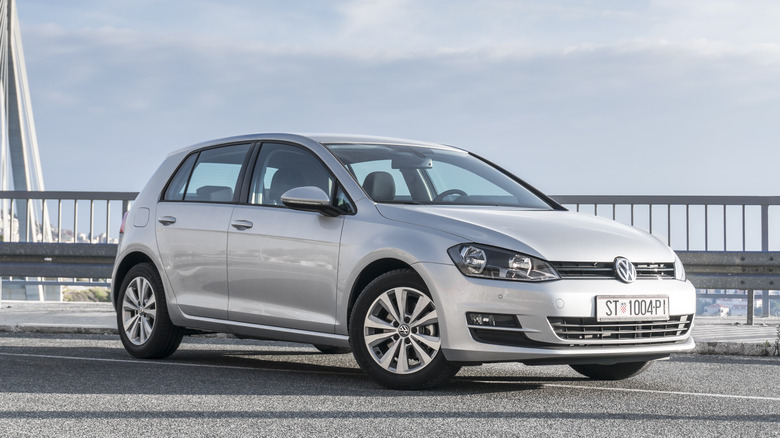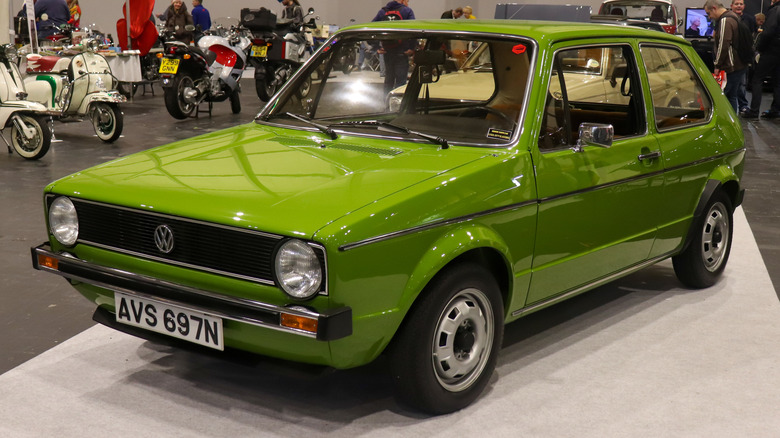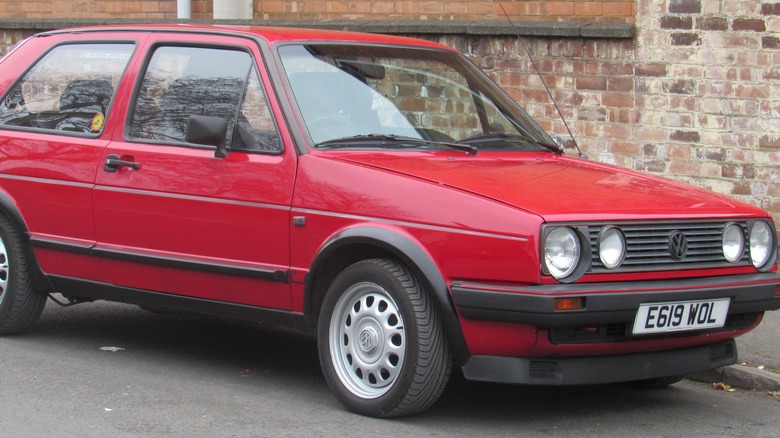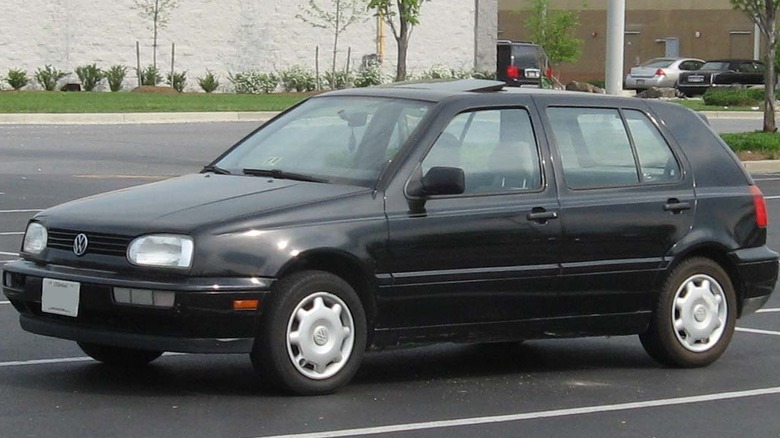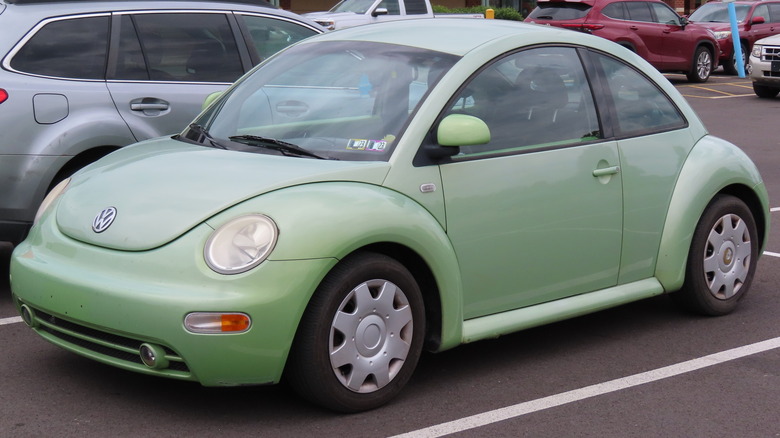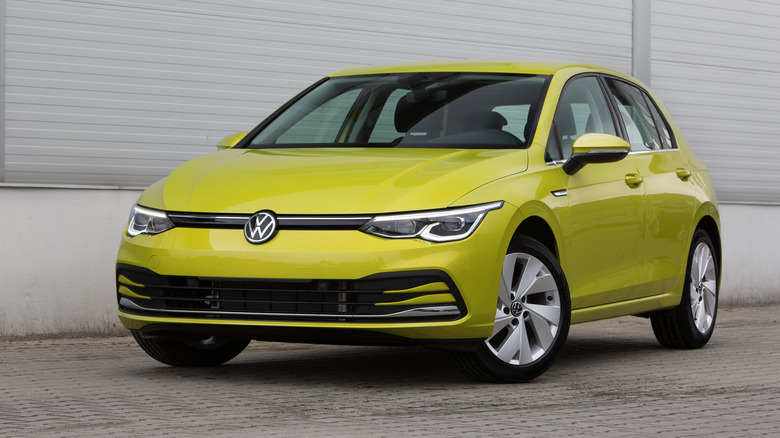Here's How The Golf Became One Of The Best Selling Volkswagen's Ever Made
When it comes to the world of small cars, Volkswagen arguably has the most iconic design in automobile history with the Volkswagen Beetle. The round vehicle first entered the world in the late 1930s, had a legendary ironic advertising campaign in the 1960s, and went through several successful redesigns until Volkswagen seized production on the Beetle in 2019. It is unusual for a car model to have a run that lasts nearly 90 years, considering style and performance tastes change as time marches on, but VW happened to hit on something that could transcend the decades.
However, that didn't mean Volkswagen was content to sit back and rest on its laurels when it came to the Beetle. It knew that, at some point, the Beetle would fall out of style and that it would need a new compact car to take its place when that happened. Starting in the 1950s, VW produced many cars intending to do just that, but none of them really took off, especially if it were to scrap the Beetle.
After 20 years of trying to find that right successor, it finally hit on one, and while it didn't initially kick the Beetle to the curb, it managed to carve out its own space as its own wonderful little vehicle. That car would be the Volkswagen Golf, and unlike the Beetle, it is still being produced to this day and will celebrate its 50th anniversary in 2024. So, what was it about the Golf that made it hit the way all the other VW Beetle replacements just couldn't?
Golf Mk1
Volkswagen's desire to find a replacement for the Beetle was not unfounded. By 1970, sales for the Beetle had declined significantly, and more than ever, the German automaker needed an update. That is when it brought in Italian car designer Giorgetto Giugario. At the time, Giugario was in a period of designing vehicles that featured hard lines and sharp curves, which became known as his "folded paper" style of design. This style was in total contrast to the Beetle, which was about as rounded a car as you were going to find on the market.
This was not the only car Giugardo was creating for Volkswagen at the time. His first design to hit the market was for the Passat, which launched a year before the Golf, and the Scirocco followed soon after. Looking at all three of these models, it's clear they share many of the same design elements, from the perfectly long rectangle front with rounded headlights to the sharply angled back. The Passat was more of a sedan, and the Scirocco was more of a sports car.
Then there was the Golf Mk1, which wound up being a smashing success. The Golf sold over six million units in its first decade of production from 1974–1983. A year into its existence, VW introduced the GTI variation to appeal to those who wanted more speed, and it also became a hit. After all the years of wanting a Beetle replacement, it looked like VW found it.
[Featured image by Vauxford via Wikimedia Commons | Cropped and scaled | CC BY-SA 4.0]
Golf Mk2
After 10 years of success, Volkswagen didn't discontinue the Golf, as had happened to many other Beetle replacement models. Instead, it gave the vehicle an update for the 1980s. From an aesthetic point of view, not much changed between the Mk1 and the Mk2. The body was slightly wider and longer than the Mk1 model, and while the basic shape of the original Giorgetto Giugardo design was still there, an effort was made to slightly round out those harsh edges around the vehicle.
This Mk2 iteration of the Volkswagen Golf was just as big of a hit as the Mk1. In fact, the sales for the two were nearly identical, with the Golf Mk2 selling 6.41 million units during its lifetime. An important note about this version of the Golf was that it was actually called the Golf in North America, where it had previously been known as the Rabbit in the United States and Canada and the Caribe in Mexico.
Car companies will frequently have different names for the same model across the world, but with the Golf, VW was streamlining it to just be the Golf. The car was successful enough that the name truly meant something.
[Featured image by Vauxford via Wikimedia Commons | Cropped and scaled | CC BY-SA 4.0]
Golf Mk3
Volkswagen rode the wave of success of the Golf Mk2 for nearly a decade before introducing the Mk3 update in 1991. Like its two predecessors, the Mk3 was another success story, selling around 4.8 million units. That may sound like a step down from the over six million that the Mk1 and Mk2 each sold, but this particular model was not in production as long as those other two, effectively being phased out after 1997 except for a convertible model. What the Mk3 has that the other two don't is a win in 1992 for European Car of the Year, showing that the love for the Volkswagen Golf was not waning in the slightest.
By now, only the vague outline of the original Mk1 design was present in the look of the vehicle. Any sharp line that remained in the Mk2 iteration basically got obliterated with this one. The original Mk1 had the vague sense of an Italian sports car, but the Mk3 bore almost none of the sleek or slightly sexy appeal of its predecessor. Of course, this was a family compact car selling in massive numbers, and sexiness — however vague — was no longer its appeal.
When 1997 rolled around, Volkswagen was ready to move onto the Mk4 model of the Golf, but that year also saw the reintroduction of a car that Volkswagen had originally been trying to phase out.
[Featured image by IFCAR via Wikimedia Commons | Cropped and scaled | Public domain]
Golf Mk4 vs. the New Beetle
The Volkswagen Golf did what the company had set out to do. While the VW Beetle never officially stopped being made, it did essentially evaporate from the market as sales of the Golf continued to prove strong. However, once the Beetle was out of the spotlight for a couple of decades, Volkswagen started planning its triumphant return. It's like when a movie studio looks through its portfolio of intellectual properties and sees what needs a revival. In the 1990s, for VW, that was the Beetle.
In 1997, it introduced the Mk4 update of the Golf and also unveiled the New Beetle. This harkening back to the past was an instant smash hit, which CNN Money called "one of the most successful new car launches ever" and reported that about 8,000 had been sold in the United States in the first month alone. Anecdotally, a day would not go by in my life growing up when I didn't see a New Beetle on the street.
You might think that would dwarf the Golf Mk4, but it didn't. That car was still winning awards and selling very well, including being the best-selling car in Europe in 2001. Despite the revived interest in the Beetle, the Golf had firmly cemented its place among the automobile community, and the two vehicles could actually coexist.
[Featured image by MercurySable99 via Wikimedia Commons | Cropped and scaled | CC BY-SA 4.0]
From Mk5 to Mk8
Production on the Golf Mk4 ended around 2003, and for the last 20 years, the Volkswagen Golf has continued to chug along. Every few years, the company puts out another new iteration of the compact car, with the most recent being the Mk8. In the United States, sales for Golf have dropped dramatically, not even cracking 10,000 units in each of the last two years. There's a chance it breaks that number in 2023 when it's all said and done, but it would be just barely crossing it. Obviously, the COVID-19 pandemic significantly affected car sales across the board, and the Golf was no exception.
That being said, sales are steadily going up, and maybe the Golf can eventually return to its steady stream of sales. It's certainly faring better than the Beetle, which is no longer in production in any capacity. So, while the New Beetle had its moment in the spotlight, the Volkswagen Golf has made it clear over the last five decades that it is the premiere compact car for the German automaker and continues to be adored by generations of people. It's always impressive when a car has withstood the test of time like the Golf has.
